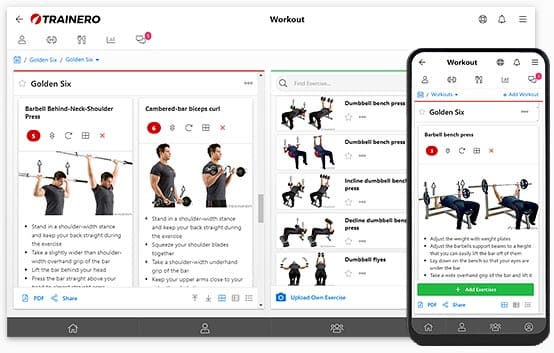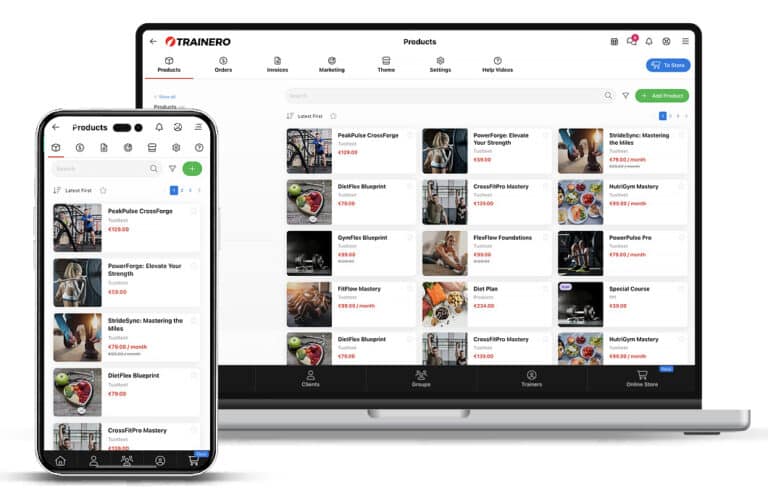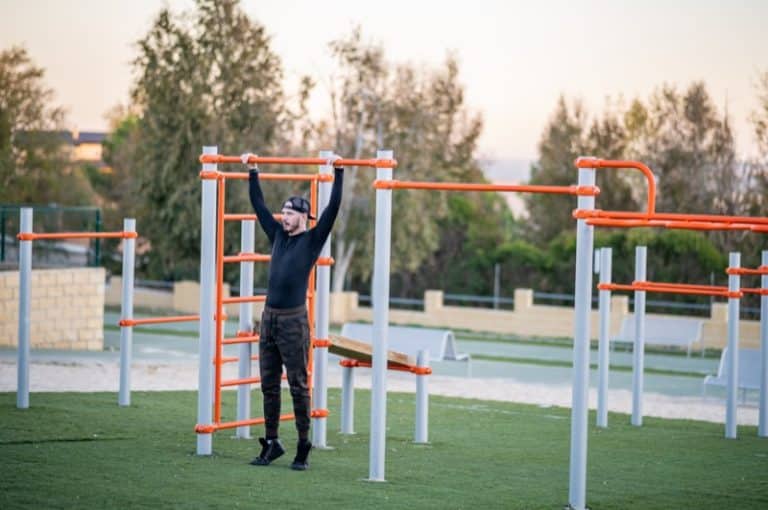Hybrid Training: Gym & Home Workout Plan for Peak Fitness
Hybrid training refers to a workout model that integrates both gym-based and home-based exercises into a cohesive fitness program. This approach allows individuals to enjoy the best of both worlds by utilizing the diverse equipment available in a gym while also taking advantage of the flexibility and convenience of training at home. Hybrid workouts often include a combination of strength training, resistance exercises, and cardiovascular activities, creating a well-rounded program that caters to various fitness levels and preferences. By alternating between different training styles, hybrid athletes can keep their routines fresh, engaging, and aligned with their fitness objectives.

Unlock your fitness potential with Trainero! Get a 14-day free trial and access personalized workout plans, expert coaching, and progress tracking—all in one app. No commitments, just results. Start your free trial today and take your fitness journey to the next level!

Benefits of Combining Gym and Home Workouts
The benefits of hybrid training are plentiful. Firstly, it provides flexibility in scheduling, as individuals can choose when and where to work out based on their personal commitments. This adaptability often leads to increased adherence to fitness programs, as workouts can be tailored to fit busy lifestyles. Moreover, combining gym sessions with home workouts enhances motivation, as individuals can switch environments to break the monotony of a standard routine. Additionally, hybrid training may facilitate a progressive overload by allowing athletes to lift heavier weights in the gym while incorporating functional movements at home. This balance can optimize strength and endurance training, ultimately fostering better overall health and fitness.
Who Can Benefit from Hybrid Training?
Almost anyone can benefit from hybrid training, regardless of their fitness background. Beginners will find that creating a hybrid workout plan allows them to incorporate fundamental exercises like squats and lunges while also engaging in cardiovascular activities like running or cycling. Intermediate and advanced athletes can use this training approach to refine their strength and endurance, mixing high-intensity interval training (HIIT) sessions at home with weightlifting in the gym. Furthermore, those preparing for competitions such as a marathon or Hyrox can tailor their hybrid workouts to improve both their aerobic capacity and muscular hypertrophy, ensuring they are well-prepared for the demands of their sports.
How to Create an Effective Hybrid Workout Plan?
Steps to Design Your Hybrid Training Program
Creating an effective hybrid workout plan involves several key steps. First, assess your current fitness level and establish clear, achievable goals. Are you looking to improve strength, enhance endurance, or achieve a specific body composition? Once your goals are set, outline a weekly schedule that includes gym and home workouts. Aim for a balance of strength training and cardio, ensuring that you are training across various intensities to maximize your results. Incorporate flexibility and mobility exercises into your routine to improve overall functional fitness and reduce the risk of injury. Finally, regularly track your progress and adjust your plan as needed to keep your workouts challenging and effective.
Balancing Strength and Cardio in Your Workout Plan
A successful hybrid workout plan should strike a balance between strength and cardio. Resistance training and cardio can be seamlessly integrated within a single workout to maximize efficiency. For instance, you might begin with a strength training segment focusing on major muscle groups using dumbbells and bodyweight exercises, followed by a cardiovascular segment that includes activities like jumping jacks or running in place. This combination not only improves strength and endurance but also helps with weight management and body composition. It’s essential to listen to your body and adjust the balance of strength and cardio based on your energy levels and fitness goals.
Choosing the Right Equipment for Home Workouts
The success of a hybrid training program often hinges on the equipment available for home workouts. While many exercises can be performed using just body weight, investing in a few key pieces of equipment can significantly enhance your training. Resistance bands, dumbbells, and kettlebells are excellent options for adding load to your strength training sessions. Additionally, a stability ball can improve your core strength and flexibility, while a jump rope can offer an effective cardio workout. Select equipment that aligns with your fitness goals and ensure you have enough space at home to perform a variety of exercises comfortably.
What Are the Best Hybrid Training Workouts for Beginners?
Starting with Basic Strength Training Exercises
For beginners, starting with basic strength training exercises is crucial to build a solid foundation. Focus on compound movements such as squats, push-ups, and deadlifts, which engage multiple muscle groups and promote functional fitness. Incorporating resistance training can help improve strength and endurance, making it easier to progress to more advanced exercises over time. Aim for two to three strength training sessions per week, ensuring you allow for adequate recovery between workouts. As you become more comfortable with these movements, consider gradually increasing the weight or resistance to continue making progress.
Incorporating Cardio into Your Routine
Cardio is an essential component of any hybrid training plan, especially for beginners looking to enhance their cardiovascular fitness. Start with moderate-intensity aerobic activities such as brisk walking, cycling, or swimming, and gradually increase the duration and intensity of your sessions. Incorporating shorter, high-intensity intervals can also be beneficial, as they can improve cardiovascular endurance and metabolism in a time-efficient manner. Aim for at least 150 minutes of moderate aerobic activity per week, and feel free to mix in different cardio modalities to keep your routine enjoyable and varied.
Progressing Safely to Avoid the Risk of Injury
As you embark on your hybrid training journey, it’s vital to progress safely to avoid the risk of injury. Start with manageable weights and gradually increase the load as your strength improves. Pay attention to your form during both strength training and cardio workouts, as proper technique is crucial for preventing injuries. Incorporate rest days into your weekly schedule to allow your body to recover and adapt to the demands of your hybrid training program. Listening to your body and adjusting your workouts based on how you feel can help you maintain a long-term and sustainable fitness regimen.
How Many Days a Week Should You Train in a Hybrid Model?
Weekly Workout Schedule for Hybrid Athletes
Determining how many days a week to train in a hybrid model depends on individual fitness levels and goals. For most hybrid athletes, a balanced schedule might include three to five workout days per week, combining strength, cardio, and flexibility training. For example, you could engage in strength training on Mondays and Thursdays, with cardio sessions on Tuesdays and Saturdays. Additionally, incorporating a flexibility session, like yoga or stretching, can enhance recovery and improve overall performance. Finding the right balance will ensure your workouts remain effective and enjoyable.
Balancing Recovery with Training Workouts
Recovery is a crucial aspect of any training program, especially when following a hybrid model. It’s essential to allow your body to rest and repair itself between training workouts to prevent overtraining and burnout. Incorporate active recovery days, where you engage in low-intensity activities like walking or gentle stretching, to promote blood flow and enhance recovery. Listen to your body; if you are feeling fatigued, consider adjusting your workout frequency or intensity. Prioritizing recovery will help you maintain a consistent training routine and achieve your fitness goals in a sustainable manner.
Adapting Your Plan Based on Fitness Goals
Your hybrid training plan should be adaptable based on your evolving fitness goals. If your objective is to improve strength, you may focus more on resistance training, while an interest in increasing endurance may lead you to prioritize cardio workouts. Regularly reassess your progress and be open to modifying your workout program to ensure it aligns with your current aspirations. This flexibility allows you to continuously challenge yourself and stay motivated on your fitness journey.
Can Hybrid Training Improve Your Body Composition?
Effects of Strength and Cardio on Body Composition
Hybrid training can significantly improve body composition by effectively combining strength and cardio workouts. Strength training not only builds muscle mass but also boosts metabolism, allowing your body to burn more calories at rest. Meanwhile, cardiovascular activities enhance fat loss and improve overall cardiovascular health. By strategically combining these elements, hybrid athletes can accelerate their progress towards their body composition goals, whether that involves losing fat, gaining muscle, or achieving a balance of both.
Tracking Progress with Hyrox and Other Competitions
For those motivated by competition, participating in events like Hyrox can provide a benchmark for tracking progress in hybrid training. These competitions are designed to test both strength and endurance, encouraging athletes to push their limits. Engaging in these events can provide a sense of accomplishment and motivation to stay committed to your training plan. Use your performance in such competitions to gauge your progress and make necessary adjustments to your hybrid workout regimen.
Adjusting Your Nutrition to Support Hybrid Training
A comprehensive hybrid training plan must also include a focus on nutrition. To support your workouts and improve body composition, ensure you are consuming a well-balanced diet rich in whole foods, lean proteins, healthy fats, and complex carbohydrates. Proper nutrition fuels your training sessions and aids in recovery, helping you achieve your fitness goals more efficiently. Stay hydrated and consider consulting with a nutritionist to tailor a dietary strategy that complements your hybrid training regimen for optimal results.

Unlock your fitness potential with Trainero! Get a 14-day free trial and access personalized workout plans, expert coaching, and progress tracking—all in one app. No commitments, just results. Start your free trial today and take your fitness journey to the next level!











